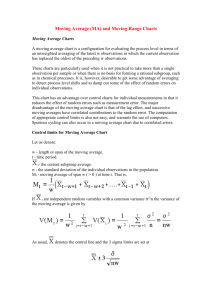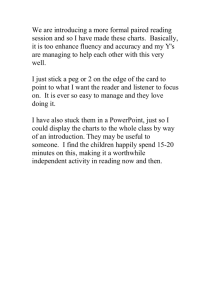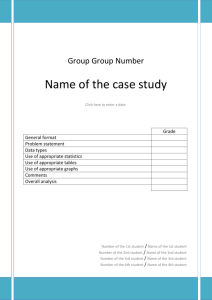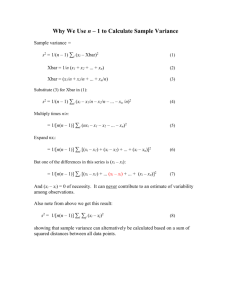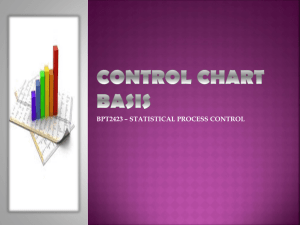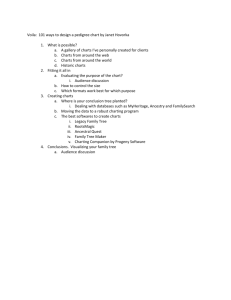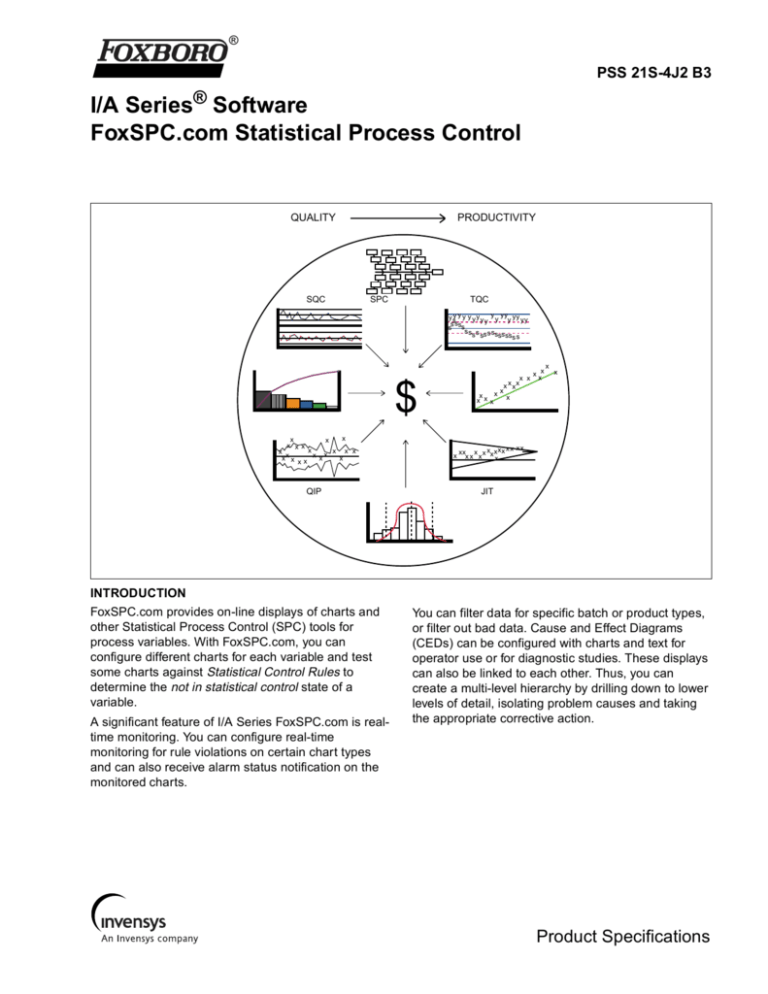
®
PSS 21S-4J2 B3
I/A Series® Software
FoxSPC.com Statistical Process Control
QUALITY
SQC
PRODUCTIVITY
SPC
TQC
y sy y y y y y y y y y yy y y y y
y
s
ss ss
s s s s s ss s
s s
s sss s
x x
x x xx
x
x x
x
x xx
$
x
x
x
x x x
x
x x x
x
x
x
xx x x x x x
QIP
x
x x
x
x
x
xx
xx x x xxx x x x x
xx x
x
JIT
INTRODUCTION
FoxSPC.com provides on-line displays of charts and
other Statistical Process Control (SPC) tools for
process variables. With FoxSPC.com, you can
configure different charts for each variable and test
some charts against Statistical Control Rules to
determine the not in statistical control state of a
variable.
A significant feature of I/A Series FoxSPC.com is realtime monitoring. You can configure real-time
monitoring for rule violations on certain chart types
and can also receive alarm status notification on the
monitored charts.
You can filter data for specific batch or product types,
or filter out bad data. Cause and Effect Diagrams
(CEDs) can be configured with charts and text for
operator use or for diagnostic studies. These displays
can also be linked to each other. Thus, you can
create a multi-level hierarchy by drilling down to lower
levels of detail, isolating problem causes and taking
the appropriate corrective action.
Product Specifications
PSS 21S-4J2 B3
Page 2
BUSINESS PLANNING & PERFORMANCE ANALYSIS
PERFORMANCE ACCOUNTING
PRODUCTION PLANNING
FINISHED PRODUCT
CONTROL
RAW MATERIAL
CONTROL
MAINTENANCE
CONTROL
PRODUCTION
CONTROL
STATISTICAL PROCESS CONTROL
PROGRAM LOGIC
BATCH MANAGEMENT
MODELS, OPTIMIZATION
ADVANCED REGULATION
DISCRETE CONTROL
BATCH CONTROL
REGULATION
MEASUREMENT & ACTUATORS
NON-DYNAMIC PROCESS
DYNAMIC PROCESS
Figure 1. Relationship to Other Process Operations
Where FoxSPC.com Fits in Your Plant Operation
Figure 1 shows where FoxSPC.com fits in relation to
other process plant operations or facility management
functions, such as production planning, performance
accounting , and statistical process control.
Consider the spectrum of processes from nondynamic processes such as automobile
manufacturing to processes like dynamic oil refining.
FoxSPC.com applies directly to the measurements
and actuators of the non-dynamic processes, while
for dynamic processes it applies at the point where
the variables have been made essentially steady
state by traditional process control. In general,
FoxSPC.com provides open loop advisory capability
for the analysis of quality problems in a plant.
FoxSPC.com is applicable at steady state, where the
variations in process and quality variables are
predominantly random.
FoxSPC.com supports on-line, on-demand analysis
capability of all process variables that are collected by
distributed historians in an I/A Series system. This
includes manually entered data and archive or
playback (restored) data for all distributed historians.
Figure 2 is a functional overview diagram of
FoxSPC.com.
Distributed historians in the I/A Series system collect
and store in databases the value, date/time, and
status of plant variables. These databases are
referred to as real-time databases.
The real-time databases are always tied to the current
time. When FoxSPC.com charts and other analysis
tools are requested, they automatically access data
from the current time backward to some time in the
past. This allows the operator to take timely corrective
action.
When requested for display and analysis, the
FoxSPC.com charts and other tools access variables
from the current time as far back as required by the
subgroup size, type, and number (count). Once a
chart is displayed, you can move both forward or
backward in time by one subgroup or half of the chart
and then redisplay the chart. You can also change the
starting time of data access, either temporarily or
permanently via on-line reconfiguration. Thus, you
can readily move on-line through the whole history of
a charted variable.
PSS 21S-4J2 B3
Page 3
Multiple process variables on FoxSPC.com charts
can be monitored in real time. When a key process
variable begins to deviate from the preconfigured
statistical control rules, an alarm is generated to alert
plant operators. Charts configured for real-time
monitoring are checked periodically regardless of
whether they are currently being displayed.
FoxSPC.com uses the following four types of
information:
• Quality Variables – Examples are viscosity,
composition, density, melt index, and brightness.
They are used in Xbar and Range, Xbar and
Sigma, Individuals, CUSUM, and Cumulative
Sum charts to monitor product quality.
• Causal Variables – Examples are flow,
temperature, pressure, and feed composition.
They are used in Xbar and Range, Xbar and
Sigma, Individuals, CUSUM, and Cumulative
Sum charts to monitor and determine the cause
of poor product quality.
• Attributes – Examples are sample size and
fraction and number of defective items, and unit
size and number of defects and defects per unit.
They are used in P, NP, C, and U charts to
monitor end (final) product and overall process
performance.
• Causal Relationships – These consist of text
information. They are organized and displayed in
CEDs.
MANUAL INPUT
HISTORIANS
(Real-Time Databases)
ARCHIVE
PROCESS
VARIABLES
RESTORE
HISTORIAN
ACCESS SERVERS
STATISCAL PROCESS CONTROL PACKAGE
VARIABLE
DATE/TIME
STATUS
FoxSPC.com Database Access Server
FoxSPC.com Display Process
FoxSPC.com Configuration Process
FoxSPC.com Report Process
Data Filtering
Real-Time Monitoring and Alarming
CED Hierarchy
Figure 2. FoxSPC.com Functional Overview
PSS 21S-4J2 B3
Page 4
FoxSPC.com TOOLS
FoxSPC.com charts and other analysis tools access
data from real-time databases that consist of quality
and causal variables, attribute variables, and causal
relationships. Therefore, FoxSPC.com tools can be
classified according to variable and analysis types as
follows:
FoxSPC.com Tools for Quality and Causal
Variables
Tools to analyze and monitor individual samples are:
• Individuals Histogram
• Individuals Chart
• Scatter Diagram for Auto-Correlation.
Tools to analyze and monitor subgrouped samples
are:
•
•
•
•
•
Xbar Histogram
Xbar and Range Chart
Xbar and Sigma Chart
CUSUM Chart
Cumulative Sum Chart.
FoxSPC.com Tools for Attribute Variables
Tools to monitor fraction and number defects are:
• P Chart
• NP Chart.
Tools to monitor defects and defects per unit are:
• C Chart
• U Chart.
FoxSPC.com Data Filtering
FoxSPC.com data filtering ignores bad or unwanted
variable data in SPC calculations.
• Data filtering is controlled by up to four separate
variables.
• SPC data can be filtered by product, batch or lot
ID.
• Ignored data can be charted as yellow triangles
or removed completely.
FoxSPC.com Tools for Cause and Effect Analysis
These tools are:
• Scatter Diagram for Cross-Correlation
• Pareto Diagram
• Cause and Effect Diagram.
PLANT ORGANIZATION USING CAUSE AND
EFFECT DIAGRAMS
Figure 3 shows the Cause and Effect Diagram, which
is also called the Fishbone diagram because of its
structure. The CED is used to document and classify
the relationships between effects and their causes.
The head of the fish indicates a specific effect
whereas the labels on the bones indicate the causes.
For distributed control and information systems
supported by communication networks, the CED not
only documents the effect and its related causes, but
also serves as a dynamic information access
mechanism. You achieve this by linking charts, text
files, or other CEDs to each cause and effect box.
The ability to link cause and effect diagrams to other
cause and effect diagrams lets you build up a
hierarchy of cause and effect relationships that mirror
the complexity of plant organizations. Each cause and
effect box is an active screen area for accessing
related charts and text. These boxes are selected by
touchscreen, mouse, or trackball.
Multi-level CEDs
Hierarchical CEDs give the operator a diagnostic tool
that mirrors the hierarchical organization of a
complex, multi-process plant. The lowest level of
CEDs might reflect the individual components of one
process or machine. The next level might cover all the
production processes for a single line or product. The
top level might encompass the entire building or plant.
When a problem arises, for example, a quality
variable for a product is out of control, the operator
can “drill down” to successively more detailed levels
of CEDs until the cause is determined.
The text files provide information for the operator
about a cause variable and its effect, and guidance
for corrective action.
You can attach any of the FoxSPC.com charts and
analysis tools that use the real-time databases to the
cause and effect boxes.
In Figure 3, the effect box represents the effect, and
cause boxes 1 through 24 represent the causes.
Each box is labelled so it can be identified.
You can link as many as four charts, other CEDs
and/or text files to the effect box and to each cause
box.
If only one chart, CED, or text file is linked to a box,
selecting the box displays the linked object. If more
than one object is linked to a box, selecting the box
displays a menu which lists the names of the linked
charts, CEDs and text files that you can select for
display.
PSS 21S-4J2 B3
Page 5
You can also divide a typical plant or process into
areas and units. Therefore, you can configure the
CEDs for the plant, areas, and units.
• Up to 11 statistical control rules per chart to
determine out of statistical control states in chart
displays
OTHER FoxSPC.com FEATURES
• Chart points that violate one or more rules are
displayed as oversized, red-colored symbols
(which appear as grey dots in Figure 4 on
page 6)
Other main features of Foxboro’s FoxSPC.com are:
• Three ways of forming subgroups for chart
calculations:
– Size – Divide a group of values into
consecutive subgroups of size n
– Size n, skip m – Choose n consecutive values
for the subgroup, and then, skip m
consecutive values
– Moving the subgroups of size n.
• Chart overlay that displays rule violations, chart
calculations, and other parameters
• User-entered notes for a specific chart and time
are available from chart displays and reports.
See Figure 4.
Figure 3. Cause and Effect Diagram
PSS 21S-4J2 B3
Page 6
• Access to Historian data in basic sample and
extended sample files, reduction groups, and
user-entered data
• PC and Web clients
• Monitoring for rule violations and alarming.
• Data filtering
• Chart movement backward or forward in time
throughout the database
• On-line reconfiguration of certain chart
parameters on the chart display, either
temporarily or permanently
• Mathematical transformations on collected
variable samples
• Option to build charts for the ratio of two variables
or for data sets formed by merging samples from
several variables
• Official and/or calculated values for the mean
and standard deviation to evaluate rules and
compute limits
• Optional display of the target, upper, and lower
specification limits on the chart
• Generation of screen images and reports
containing charts, raw values, calculated values,
and notes
• Configuration of charts and CED displays,
with on-line configuration editing and reporting
• Individuals Histogram for determination of
normality and calculation of process capability
indices for individual samples
• Xbar Histogram for determination of normality
and calculation of process capability indices for
subgroup mean values
• Scatter diagram for cross-correlation of variables
with optional time shift
• Scatter diagram for auto-correlation of a variable
with selected time shift
• Pareto diagram that plots the number of
occurrences of rejection and the percent
contribution for up to 16 causes of rejection for a
product.
To evaluate the rules and compute the control limits,
you can use official or calculated values for the mean
and/or standard deviation.
Official values are obtained for a variable by moving
in time through the database, selecting a set of
samples as the standard set to judge the future, and
computing the required official values.
Figure 4. Xbar and Range Chart with Rule Violation and Note
PSS 21S-4J2 B3
Page 7
Mathematical transformations are useful when the
variable itself is not normally distributed, but a
function of the variable is normally distributed. For
example, a log-normal distribution is transformed to
normal via the natural log function.
As an aid to the operator, FoxSPC.com chart displays
perform up to 11 statistical-control-rule checks and
inform the operator if the plotted data is out of
statistical control as well as monitoring and alarming
for up to three rule violations.
First, you select and observe the charts for a product
quality variable and interpret them. Next, you use the
CEDs to access variables that cause out of statistical
control states. Then, you observe the charts for those
variables and implement the necessary control
actions.
Typical control actions consist of:
• Changing appropriate variable set points
and/or targets
• Retuning the controllers, and modifying
associated control functions
• Improving control of upstream units to minimize
the introduction of systematic variation into the
downstream process.
FoxSPC.com CHARTS AND TOOLS
FoxSPC.com provides 13 types of charts and tools:
•
•
•
•
•
•
•
•
•
•
•
•
•
Individuals Chart
Xbar and Range Chart
Xbar and Sigma Chart
Cumulative Sum Chart
CUSUM Chart
Individuals Histogram
Xbar Histogram
P Chart
NP Chart
C Chart
U Chart
Scatter Diagram
Pareto Diagram
FoxSPC.com charts and tools define all information
necessary to:
• Retrieve collected process data for ratioing,
merging, transformation, and subgrouping
• Perform the statistical calculations appropriate to
the chart type
• Plot and display the results
• Apply statistical control rules to the data to
determine when the variable is out of statistical
control
• Monitor and generate alarms for up to three rule
violations.
The chart display presents the chart, as configured,
and allows the operator or analyst to:
• Display chart help text
• Display chart parameters
• Change chart parameters, either temporarily or
permanently
• Display the results of internal chart calculations
• Change screen background color to white for
printing
• Print a standard chart report.
Optionally, you can display the target and upper and
lower specification limits on the chart.
In the charts, the central line (mean) is labelled CL,
when calculated from the data. When based on the
official mean, it is labelled OCL.
In the charts, the upper and lower control limits are
labelled UCL and LCL, when based on the calculated
sigma. When based on the official sigma, they are
labelled OUCL and OLCL.
PSS 21S-4J2 B3
Page 8
Individuals Chart
Figure 5 shows the Individuals chart. It is a plot of a
group of individual measurement values versus time
or subgroup, together with their mean and the upper
and lower control limits. The subgroup size is always
1 for this chart.
The software can calculate the mean and control
limits from the actual data, or it can base them on
official values of the mean and standard deviation
(sigma).
The software monitors up to three of these rules, and
generates an alarm when a violation occurs.
You can also display the target (TAR), upper
specification limit (USL), and lower specification limit
(LSL) on the chart, along with the calculated or official
central line (mean) and calculated or official control
limits.
You can apply any one of the variable transformations
listed under Functional Specifications on page 26 to
the values for this chart, except for merge.
When the chart is displayed, the software checks up
to 11 preconfigured rules for violations and displays
the results (rules violated by which subgroups).
Figure 5. Individuals Chart
PSS 21S-4J2 B3
Page 9
Xbar and Range Chart
Figure 6 shows the Xbar and Range chart, which is a
double chart. The upper chart is a plot of subgroup
mean values versus time or subgroup, together with
their mean value (the grand mean), and the upper
and lower control limits.
When the chart is displayed, the software checks up
to 11 preconfigured rules for violations and displays
the results (rules violated by which subgroups).
The software monitors up to three of these rules, and
generates an alarm when a violation occurs.
The lower chart is a plot of subgroup range values
versus time or subgroup, together with the range
mean and the range upper and lower control limits.
You can also display the targets, upper specification
limits, and lower specification limits on the chart,
along with the calculated or official central lines
(means) and calculated or official control limits.
The software can calculate the mean and control
limits from the actual data, or base them on official
values of the Xbar mean and range mean.
You can apply any one of the variable transformations
listed under Functional Specifications on page 26 to
the values for this chart.
Figure 6. Xbar and Range Chart
PSS 21S-4J2 B3
Page 10
Xbar and Sigma Chart
Figure 7 shows the Xbar and Sigma chart, which is a
double chart. The upper chart is a plot of subgroup
mean values versus time or subgroup, together with
their mean value (the grand mean), and the upper
and lower control limits.
The lower chart is a plot of subgroup sigma values
versus time or subgroup, together with the sigma
mean and the sigma upper and lower control limits.
The software can calculate the mean and control
limits from the actual data, or base them on official
values of the mean and sigma.
When the chart is displayed, the software checks up
to 11 preconfigured rules for violations and displays
the results (rules violated by which subgroups).
The software monitors up to three of these rules, and
generates an alarm when a violation occurs.
You can also display the targets, upper specification
limits, and lower specification limits on the chart,
along with the calculated or official central lines
(means) and calculated or official control limits.
You can apply any one of the variable transformations
listed under Functional Specifications on page 26 to
the values for this chart.
Cumulative Sum Chart
Figure 8 shows the Cumulative Sum chart, which
displays the cumulative deviation of the subgroup
mean from the target value.
The chart control limits are in the form of a V-mask
that provides a two-sided decision criteria similar to
the 3-sigma limits of the Xbar chart.
The software can calculate the standard deviation of
the mean values from the actual data, or base them
on official values of the mean and sigma.
You can apply any one of the variable transformations
listed under Functional Specifications on page 26 to
the values for this chart.
CUSUM Chart
Figure 9 shows the CUSUM chart, which displays the
cumulative deviation of the subgroup mean from the
target value, divided by the sample standard deviation
of the subgroup.
Figure 7. Xbar and Sigma Chart
PSS 21S-4J2 B3
Page 11
Figure 8. Cumulative Sum Chart
PSS 21S-4J2 B3
Page 12
Figure 9. CUSUM Chart
This chart is a plot of S and Y versus time or
subgroup where:
S = cumulative deviation value
Y = [(subgroup mean) - target] + standard deviation.
The chart also shows the target value (TAR), decision
intervals (h1 and h2), and slack values (k1 and k2).
You can apply any one of the variable transformations
listed under Functional Specifications on page 26 to
the values for this chart.
Individuals Histogram
Figure 10 shows an Individuals Histogram with the
normal curve superimposed. This chart is a
frequency distribution of a set of data. It is a plot of
the count of points as a function of value.
The software calculates the standard deviation of the
data and uses this value and the mean to plot the
superimposed normal curve.
This chart also shows the target (TAR), upper
specification limit (USL), and lower specification limit
(LSL). You enter these values.
You can use the Individuals Histogram for process
capability analysis and determination of the normality
of data. The software calculates the standard
capability indices, as well as mean, standard
deviation, skewness, kurtosis and percent out of
specification.
You can apply any one of the variable transformations
listed under Functional Specifications on page 26 to
the values for this chart, except for merge.
PSS 21S-4J2 B3
Page 13
Figure 10. Individuals Histogram
PSS 21S-4J2 B3
Page 14
Xbar Histogram
Figure 11 shows an Xbar Histogram with the normal
curve superimposed. This chart is a frequency
distribution of a set of subgroup means. It is a plot of
the count of means as a function of value.
The software calculates the standard deviation of the
data and uses this value and the mean value to plot
the superimposed normal curve.
This chart also shows the target (TAR), upper
specification limit (USL), and lower specification limit
(LSL). You enter these values.
You can use the Xbar Histogram for process
capability analysis and determination of the normality
of data. The software calculates the standard
capability indices, as well as mean, standard
deviation, skewness, kurtosis and percent out of
specification.
You can apply any one of the variable transformations
listed under Functional Specifications on page 26 to
the values for this chart.
Figure 11. Xbar Histogram
PSS 21S-4J2 B3
Page 15
P Chart
Figure 12 shows the P chart. It is a plot of the fraction
of defective items versus time or subgroup, together
with the mean value and upper and lower control
limits.
The P chart is useful when the number of tested
items varies from sample to sample, that is, subgroup
to subgroup. When the number of tested items per
subgroup is constant, the NP chart shown in
Figure 13 is used instead of the P chart.
Optionally, you can plot percent defective instead of
fraction defective.
The software can calculate the mean and control
limits from the actual data, or it can base them on
official values of the mean and sigma.
When the chart is displayed, the software checks up
to 11 preconfigured rules for violations and displays
the results (rules violated by which subgroups).
The software monitors up to three of these rules, and
generates an alarm when a violation occurs.
You can also display the target (TAR), upper
specification limit (USL), and lower specification limit
(LSL) on the chart, along with the calculated or official
central line (mean) and calculated or official control
limits.
This chart does not use any variable transformations.
Figure 12. P Chart
PSS 21S-4J2 B3
Page 16
NP Chart
Figure 13 shows the NP chart. It is a plot of the
number of defective items versus time or subgroup,
together with the mean value and the upper and lower
control limits.
When the chart is displayed, the software checks up
to 11 preconfigured rules for violations and displays
the results (rules violated by which subgroups).
The software monitors up to three of these rules, and
generates an alarm when a violation occurs.
The NP chart is useful when the number of tested
items per subgroup is constant, as specified by the
subgroup size parameter. When the number of tested
items per subgroup varies, the P chart is used instead
of the NP chart.
You can also display the target (TAR), upper
specification limit (USL), and lower specification limit
(LSL) on the chart, along with the calculated or official
central line (mean) and calculated or official control
limits.
The software can calculate the mean and control
limits from the actual data, or it can base them on
official values of the mean and sigma.
This chart does not use any variable transformations.
Figure 13. NP Chart
PSS 21S-4J2 B3
Page 17
C Chart
Figure 14 shows the C chart. It is a plot of the number
of defects versus time or subgroup, together with the
mean value and the upper and lower control limits.
The C chart is useful when the unit size is constant.
An example is the number of defects in a yard of
cloth, where the unit size is a yard of cloth every time.
When the unit size varies, the U chart is used instead
of the C chart. See Figure 15 on page 18.
The software can calculate the mean and control
limits from the actual data, or it can base them on
official values of the mean and sigma.
When the chart is displayed, the software checks up
to 11 preconfigured rules for violations and displays
the results (rules violated by which subgroups).
The software monitors up to three of these rules, and
generates an alarm when a violation occurs.
You can also display the target (TAR), upper
specification limit (USL), and lower specification limit
(LSL) on the chart, along with the calculated or official
central line (mean) and calculated or official control
limits.
This chart does not use any variable transformations.
Figure 14. C Chart
PSS 21S-4J2 B3
Page 18
U Chart
Figure 15 shows the U chart which is a plot of the
number of defects per unit versus time or subgroup,
together with the mean value and the upper and lower
control limits.
The U chart is useful when the unit size varies. An
example is the number of defects per yard of cloth
where the unit size is 1 yard of cloth for the first
subgroup, 1.35 yards of cloth for the second
subgroup, etc. When the unit size is constant, the
C chart shown in Figure 14 is used instead of the
U chart.
When the chart is displayed, the software checks up
to 11 preconfigured rules for violations and displays
the results (rules violated by which subgroups).
The software monitors up to three of these rules, and
generates an alarm when a violation occurs.
You can also display the target (TAR), upper
specification limit (USL), and lower specification limit
(LSL) on the chart, along with the calculated or official
central line (mean) and calculated or official control
limits.
This chart does not use any variable transformations.
The software can calculate the mean and control
limits from the actual data, or it can base them on
official values of the mean and sigma.
Figure 15. U Chart
PSS 21S-4J2 B3
Page 19
Scatter Diagram
Figure 16 shows the Scatter Diagram. This diagram is
a plot of one variable against another or itself, with a
computed linear regression line superimposed on the
plot. This diagram displays, graphically and with a
computed value, the cross-correlation between two
variables or a variable’s auto-correlation. An optional
time shift compensates for the time delay between
these variables.
The Scatter Diagram provides a visual display of the
correlation between the two variables. The software
computes and displays the value of the
cross-correlation coefficient to provide a quantitative
measure of the correlation between the variables. The
software also computes and plots a linear regression
line on the diagram.
The software can also plot a variable against itself on
the Scatter Diagram, thus showing, graphically and
with a computed value, its auto-correlation. You can
configure the diagram for different time delays to
display the computed auto-correlation of the variable.
You can apply any one of the variable transformations
(except for merge), listed under Functional
Specifications on page 26 to the values for this chart.
The ratio transformation allows you to plot one
variable against the ratio of two other variables or the
ratio of two variables against the ratio of two other
variables.
Figure 16. Scatter Diagram
PSS 21S-4J2 B3
Page 20
Pareto Diagram
Figure 17 shows the Pareto Diagram which
graphically displays, in order of priority, up to 16
causes of rejection for a produc t. This diagram plots
the number of occurrences of rejection and percent
contribution, both charted versus cause of rejection.
The software can also plot the sum of occurrences for
any given period of time, for example 30 days, using a
Pareto Diagram. It provides weighting coefficients to
convert the number of occurrences to whatever is
desirable, including dollars.
The Pareto Diagram is most commonly used for
attribute variables. It has two y-axes.
The y-axis on the left is for the number of occurrences
of product rejection versus causes for rejection, in
order of priority. It is associated with the bar graph.
The y-axis on the right represents cumulative percent
contribution for the same causes of rejection, and it is
associated with the curve with the • symbol.
You enter the number of causes for rejection and the
name for each cause during chart configuration.
This chart does not use any variable transformations.
Figure 17. Pareto Diagram
PSS 21S-4J2 B3
Page 21
DATA COLLECTION AND ACCESS
REAL-TIME MONITORING AND ALARMING
The Historian performs the data collection.
FoxSPC.com accesses the following Historian data:
The I/A Series FoxSPC.com (50 Series) software
package provides real-time monitoring and alarming
capability for the following chart types:
• Basic and extended sample data
• Reduction group data
• Manual entry group data
• Archive or playback (restored) files for any of the
above.
For sample data, which is collected on a
change-driven basis, FoxSPC.com builds charts with
the collected data, converted to periodic values,
based on the sample period for the chart.
Because reduction group data is collected
periodically, FoxSPC.com treats it as periodic data in
the charts.
User-entered data istreated as nonperiodic values.
FoxSPC.com accesses collected samples in four
ways:
• From start time/date, number of subgroups
backward in time
• From start time/date, number of subgroups
forward in time
• From start time/date, a time span backward in
time
• From start time/date, a time span forward in time.
The start time/date defaults to the current system
time/date.
For charts that require them, there are three ways of
forming subgroups for chart calculations:
• Size n – Divide a group of values into
consecutive subgroups of size n
• Size n, skip m – Choose n consecutive values for
the subgroup, and then, skip m consecutive
values
• Moving Subgroups of Size n – Given the group of
values X 1...X N, the jth subgroup of size n where
J = 1...N, is formed with the values X J+I-1, where
i = 1...n.
•
•
•
•
•
•
•
•
Individuals
Xbar and Range
Xbar and Sigma
CUSUM
P
NP
C
U.
The FoxSPC.com monitor process executes
periodically, monitoring charted Historian sample and
manually entered data variables for out of statistical
control conditions.
During each chart’s monitor period, the monitor
obtains sufficient data from the Historian to check the
latest subgroup of samples for rule violations.
Rule violations result in alarm status changes for
charts configured for monitoring. When a status
changes, an alarm message is sent to the configured
printer and the I/A Series alarm display is updated
with the latest alarm information.
With the exception of CUSUM charts, which use a
configured decision interval h, each monitored
chart may use up to three rules chosen from the
11 FoxSPC.com standard “Statistical Control Rules
for Charts” on page 26.
A CED box turns red when a chart to which it is linked
goes into an alarm condition. The text foreground of
the linked menu item also turns red.
Charts may be configured to be monitored as
frequently as once per minute.
Alarms can be acknowledged or deleted from this
display.
The I/A Series alarm display is updated once per
minute.
PSS 21S-4J2 B3
Page 22
The FoxSPC.com Real-time Monitor and Alarm
Package can monitor and relay alarm status on the
following types of charts:
• Individuals
• Xbar and Range
• Xbar and Sigma
Chart Configuration
You configure each chart as a separate, named
instance of one of the supported chart types. You can
add, modify, copy, delete, and report chart definitions.
You can configure certain types of charts for real-time
monitoring and alarming.
Chart definitions provide all information necessary to:
• CUSUM
• Retrieve collected process data
• P (Fraction defective for variable number of
tested items)
• Ratio, merge, or transform the data
• NP (Number of defects for constant number of
tested items)
• Filter the data
• C (Number of defects for constant unit size)
• Perform calculations appropriate to the chart type
• U (Number of defects per unit for variable unit
size).
• Plot and display results of these operations
CONFIGURATION
FoxSPC.com is configured from a workstation using
the FoxSPC.com configurator which interacts with the
user via workstation displays and updates the
FoxSPC.com definition files via an access server.
The FoxSPC.com configuration environment provides
the following selectable options:
• Display configuration help text
• Display list of charts that have been configured
• Display list of CEDs that have been configured
• Generate Foxboro defined configuration reports
• Repack FoxSPC.com configuration files
• Display list of available FoxSPC.com packages in
the system
• Go to FoxSPC.com operation
• Exit FoxSPC.com configuration.
• Subgroup the data
• Check rules for out of statistical control state
• Monitor and relay alarm status appropriate to the
chart types.
You do not needto configure Historian variables in the
Historian prior to FoxSPC.com chart configuration.
Cause and Effect Diagram Configuration
You configure each CED as a separate, named
definition. The definition specifies the number,
position, and title of boxes in the CED, as well as the
charts, CEDs, and text files linked to the boxes. You
can add, modify, copy, delete, and report CED
definitions.
PSS 21S-4J2 B3
Page 23
Cause and Effect Diagram Displays
CED displays provide the following selectable options:
• Display CED help text
• Display chart selected from list of configured
charts (charts being monitored are shown in
yellow)
• Display CED selected from list of configured
CEDs
• Change screen background color to white for
printing
• Display list of available Statistical Process
Control packages in the system
• Go to FoxSPC.com configuration
• Exit FoxSPC.com operation
• Return to previous CED or chart display.
FoxSPC.com performs the following operations to
generate the chart display:
1. Retrieves variable samples for the chart:
– When the chart is configured for a desired
number of variable samples, FoxSPC.com
computes the number of variable samples,
based on the configured subgroup size,
number of subgroups, and subgrouping
method.
– When the chart is configured for all available
samples for a specific time span, FoxSPC.com
retrieves all sample values collected within this
time span and forms subgroups for these.
2. Performs the configured variable transformation
(if any) on the samples.
3. Forms subgroups according to the configured
subgrouping method.
4. Data filtering.
Chart Displays
5. Performs the appropriate statistical calculations.
Chart displays provide the following selectable
options:
6. Plots the results using the configured plot line
type.
• Display chart help text
• Display chart selected from list of configured
charts (charts being monitored are shown in
yellow)
• Display CED selected from list of configured
CEDs
• Display chart point information
• Display/enter chart notes (not in Scatter, Pareto,
or Histogram charts)
• Display calculated values for chart parameters
• Display/change chart configuration parameters,
either temporarily or permanently
• Stop/Start Real Time Monitoring button
• Move chart data backward or forward in time by
one subgroup or half of the chart
• Change screen background color to white for
printing
• Print selected operation report from list of
standard chart reports
• Exit FoxSPC.com operation
• Return to previous chart or CED display.
7. Performs any configured statistical control rule
checks, and then plots the points in violation as
oversized, red dots.
8. Monitoring and alarming.
REPORT GENERATION
FoxSPC.com provides a set of predefined
configuration reports that are requested via the
Reports field in the top menu bar of FoxSPC.com
configuration displays.
FoxSPC.com also provides operational reports that
are requested via the Reports field in the top menu
bar of chart displays.
For example, you can call up a chart for display,
change its parameters, and generate a report
consisting of tables of raw and calculated values and
notes for the selected time period. You can also
obtain a hard copy of the plotted chart by using the
Prntprep field in the top menu bar of the chart display
in conjunction with the I/A Series print screen
function.
PSS 21S-4J2 B3
Page 24
SYSTEM CONFIGURATION
WINDOWS CHART CONFIGURATOR
The FoxSPC.com software executes on the following
Solaris-based 50 Series and 70 Series stations:
The configurator allows chart configuration and
adjustment from any machine with access to the
FoxSPC.com server.
• Application Processor in conjunction with a
Workstation Processor
PC AND WEB CLIENTS
• Application Workstation (AW) which can host
WPs.
FoxSPC.com residing on an AP can service all WPs
hosted by the AP. FoxSPC.com configuration and
displays are performed locally within the AP/WP
cluster. Process data is accessed from any Historian
database in the I/A Series network. See Figure 18.
The FoxSPC.com software package can access data
from the local Historian (database) and all remote
Historians (databases) in the I/A Series network.
PC client stations can access FoxSPC.com displays
over an Ethernet TCP/IP local area network. PC
clients can run under Microsoft Windows 95/98, or
Windows NT 4.0 operating systems.
An optional Web server can be added to the network
to allow remote access to FoxSPC.com displays
using Netscape Navigator or Microsoft Internet
Explorer over the Internet or a corporate intranet.
REAL TIME FoxSPC.com SYSTEM ARCHITECTURE
Web Browser Client (option)
[Java-enabled Navigator
or Internet Explorer]
Web Server (option)
Windows PC Clients (option)
[Windows 95/98, and NT 4.0]
Ethernet TCP/IP
I/A Series Clients
50 Solaris
Series AW/AP
FoxSPC.com
Server
WP/AW 50 Series
(SunOS or Solaris)
AW70 Server
Nodebus
I/A Series
• CPs
• APs
• FBMs
Figure 18. Diagram of System Architecture
AW70
WP70
PSS 21S-4J2 B3
Page 25
FoxSPC.com PRODUCT STRUCTURE
FoxSPC.com uses client server architecture as shown
in Figure 18. The product is structured to be cost
effective and to accommodate the needs of most
applications. The product structure requires one SPC
server and can accommodate any combination of
I/A Series UNIX, Windows, or Internet/intranet clients.
When you order at least one SPC server, the
appropriate number and type of clients should be
specified.
Foxboro also offers a packaged solution that includes
all hardware and software needed to put a SPC
system on the Internet or intranet. The packaged
solution includes complete installation and testing of
software on the server. The following paragraphs are
a description of the available product components.
FoxSPC.com Server Software
The FoxSPC.com server provides all the software
needed to configure SPC charts, CEDs, and other
SPC tools. It also includes software needed to
support all of the connected I/A Series UNIX clients
that are connected to the Nodebus. No additional
software is needed for I/A Series UNIX clients.
Software is also included to provide client license
validation to support other software client types. At
least one SPC server is needed to support a
FoxSPC.com system.
FoxSPC.com Windows clients are sold as named
user licenses. A named user can log onto the system
from any PC that is connected to the TCP/IP
information network as long as the correct user name
and password are entered.
The Windows clients do not allow users to do SPC
configuration. On allowable chart types, users have
access to the parameters, calculations and other
functions. Items can be changed by a user on an
ad hoc basis but the changes can not be permanently
saved. The alarm state of a chart or CED is shown
when a display is called on a Windows client but new
alarms that occur will not update the display. The
Windows client does not directly support printing
except for print screen functions.
FoxSPC.com Internet/Intranet (Web) Server
Software
FoxSPC.com can also be accessed over the Internet
or a company Intranet. The FoxSPC.com software
allows the same functionality as the Windows clients.
The Internet/intranet server software can be loaded
on the SPC server or another server. This software
makes all of the SPC client functions available for a
user supplied Web server.
FoxSPC.com Web licenses are sold as named user
licenses. A named user can log onto the SPC Web
server but is allowed access only if a correct user
name and password are entered.
FoxSPC.com Windows Clients Software
FoxSPC.com Windows clients will run on
Windows 95/98, or Windows NT 4.0. From a Windows
client, users have access to the full range of SPC
charts, CEDs and other SPC tools. The Windows
client look and feel are similar to the UNIX client with
small changes in color, menus and fonts. Placement
and behavior of buttons, however, are more
consistent with the Windows environment.
When using the FoxSPC.com Windows client, data
can be exported to spreadsheets, wordprocessors
and other Windows DDE applications. Data that is
transferable includes all plotted data values, and SPC
calculation results (target, sigma, cpk, etc.) for any
displayed chart.
FoxSPC.com Internet Packaged Solutions
Foxboro can, as an option, provide a fully loaded and
tested FoxSPC.com Internet/intranet server including
the hardware.
FoxSPC.com Engineering Services
Foxboro can supply on-site engineering services to
install a basic FoxSPC.com software package and
provide basic FoxSPC.com user training.
FoxSPC.com Web enabler software installation can
also be provided on site.
PSS 21S-4J2 B3
Page 26
SYSTEM REQUIREMENTS
FoxSPC.com is available on the following platforms:
FoxSPC.com Servers
• Solaris operating system
• I/A Series AP/AW51B, C, D, or E with an
information network connection using a second
Ethernet port
• I/A Series AW70
• 32 MB RAM, minimum. Additional clients will
require more memory
• 30 MB of hard drive, minimum.
Clients - Personal Computers
• Pentium or 486 class PC
FUNCTIONAL SPECIFICATIONS
FoxSPC.com Tools
• Individuals Chart
• Xbar and Range Chart
• Xbar and Sigma Chart
• Cumulative Sum Chart
• CUSUM Chart
• Individuals Histogram
• Xbar Histogram
• P Chart
• NP Chart
• C Chart
• U Chart
• Scatter Diagram
• Pareto Diagram
• Cause and Effect Diagram.
• Windows 95/98, or Windows NT 4.0
Statistical Control Rules for Charts
• 16 MB RAM, minimum
UP TO 11 RULES PER CHART
• Network interface card for Windows clients and
Win-Socket compliant TCP/IP software.
Rule 1
Clients - Web
• Java-enabled Web browser (Netscape Navigator
or Microsoft Internet Explorer)
Clients - I/A Series
• I/A Series software Version 4.1 or higher on
AW51 or WP51 or AW70A, B, C, D, or E running
Solaris with an information network connection
which uses a second Ethernet port
• 12 MB RAM, minimum
• WP30 systems are not supported, but can be
upgraded to the I/A Series 50 via The Foxboro
Company Advantage Program
• AW/WP51 and AW70 systems must
communicate to the FoxSPC.com server via the
Nodebus.
1 point outside ±3 sigma of the central
line.
Rule 2 3 consecutive points jumping ±3 sigma or
more.
Rule 3 2 of 3 consecutive points above +2 sigma
or below -2 sigma from the central line.
Rule 4 4 of 5 consecutive points above +1 sigma
or below -1 sigma from the central line.
Rule 5 8 consecutive points above the central
line.
Rule 6 8 consecutive points below the central
line.
Rule 7 5 consecutive points increasing in value.
Rule 8 5 consecutive points decreasing in value.
Rule 9 15 consecutive points within ±1 sigma of
the central line.
Rule 10 8 consecutive points outside ±1 sigma of
the central line.
Rule 11 After a jump of ±3 sigma, 3 consecutive
points within ±0.75 sigma of the jump
point.
PSS 21S-4J2 B3
Page 27
Variable Transformation Options(1)
TYPE 0
None
TYPE 1
y = c1 x
TYPE 2
y = c1 (loge x)
TYPE 3
TYPE 4
y = c1 x + c 2
y = c1 exp (c2x)
TYPE 5
y = c1 √x
TYPE 6
RATIO
y = xc1
y = c1 (x/z)
MERGE
Merge up to 8 variables so that each
subgroup contains one sample from each
variable.
Input Historian Data
• Basic and extended samples
• Reduction group data
• Manual entry data
• Archive or playback data.
Installation
One FoxSPC.com per 50 Series station
Printer Requirements
CONFIGURATION REPORTS
Dot-Matrix or Color Ink-Jet (PaintJet) Printer
PRINT SCREEN FUNCTION
Color Ink-Jet (PaintJet) Printer
(1) In transformation equations, x and z are variable values. C1 and C2 are user defined constants.
PSS 21S-4J2 B3
Page 28
The Foxboro Company
33 Commercial Street
Foxboro, Massachusetts 02035-2099
United States of America
http://www.foxboro.com
Inside U.S.: 1-508-543-8750 or 1-888-FOXBORO (1-888-369-2676)
Outside U.S.: Contact your local Foxboro Representative.
Fox, Foxboro, and I/A Series are registered trademarks of The Foxboro Company.
Windows 95, Windows 98, Windows NT, and Internet Explorer are trademarks of Microsoft Corp.
UNIX is a trademark of X/Open Company Limited.
Java and Solaris are trademarks of Sun Microsystems, Inc.
Pentium is a trademark of Intel Corporation.
PaintJet and InkJet are trademarks of Hewlett-Packard Company.
Copyright 1997-1999 by The Foxboro Company
All rights reserved
MB 021
An Invensys company
Printed in U.S.A.
0299

